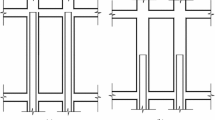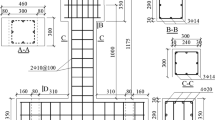Abstract
Four types of seismic design details were tested using 11 transfer column specimens and one comparison specimen of RC under low cyclic reversed loading. Test results show that diagonal cracks control the failure pattern and damage occurs mainly in the RC section with weak shear capacity in the transfer columns. There is a large difference in the bearing capacity and ductility of the transfer columns according to the test results, which indicates that the strengthening effect of diverse structural measures is quite different. The section ratio of I-section-encased steel and the axial compression ratio also have a great influence on the bearing capacity and ductility. Although the bearing capacity of transfer columns with additional longitudinal bars and additional X bars is relatively large, they have poor deformation capacity. Setting more stirrups along the columns is the best structural measure to enhance the seismic performance. The studs on the I-section-encased steel by welding can help to complete the stress transfer between the steel and concrete, and avoid performance degradation of the two materials due to bonding failure.
Similar content being viewed by others
Abbreviations
- h :
-
Height of cross section (mm)
- b :
-
Width of cross section (mm)
- I :
-
Clear height of specimens (mm)
- n :
-
Axial compression ratio (-)
- N :
-
Axial load (kN)
- f c :
-
Axial compressive strength of concrete (MPa)
- A :
-
Cross section area of specimens (mm2)
- p :
-
Section ratio of I-section-encased steel (-)
- ρ ss :
-
Section ratio of I-section-encased steel (-)
- L ss :
-
Extended length of I-section-encased steel in transfer columns (mm)
- s :
-
Spacing of stirrups (mm)
- d :
-
Diameter of stirrups (mm)
- f y :
-
Yield tensile strength (MPa)
- f u :
-
Ultimate tensile strength (MPa)
- E s :
-
Elastic modulus (MPa)
- Q :
-
Shear force at both ends of the column (kN)
- M :
-
Bending moment at both ends of the column (kN·m)
- P :
-
Lateral load (kN)
- P c :
-
Lateral load at cracking condition (kN)
- P y :
-
Lateral load at yielding condition (kN)
- P m :
-
Lateral load at peak condition (kN)
- P mo m :
-
Largest Pm in specimens SRC4-2-JM, SRC4-4-JMrSRC4-2-SD7SRC4-2-FJ, SRC4-4-X, SRC4-2-N (kN)
- P u :
-
Lateral load at ultimate condition (kN)
- D c :
-
Ratio of lateral load to displacement at cracking condition (kN/mm)
- θ :
-
Drift ratio (-)
- θ u :
-
Drift ratio at ultimate condition (-)
- μ :
-
Displacement ductility ratio (-)
- μ 0 :
-
Largest μ in specimens SRC4-2-JM, SRC4-4-JM, SRC4-2-SD, SRC4-2-FJ, SRC4-4-X, SRC4-2-N (-)
- Δ :
-
Lateral displacement at the top of the column (mm)
- Δ y :
-
Lateral displacement at yielding condition (mm)
- Δ u :
-
Lateral displacement at ultimate condition (mm)
- W :
-
Cumulative dissipated energy obtained from the sum areas of hysteresis loops in the full load-history (kN·m)
- W 0 :
-
Largest W in specimens SRC4-2-JM, SRC4-4-JM, SRC4-2-SD, SRC4-2-FJ, SRC4-4-X, SRC4-2-N (kNm)
References
ACI 318-14 (2014), Building Code Requirements for Structural Concrete, American Concrete Institute. America.
AISC LRFD-99 (1999), Load and Resistance Factor Design Specification for Structural Steel Buildings, American Institute of Steel Construction, America.
Azizinamini A and Ghosh SK (1997), “Steel Reinforced Concrete Structures in 1995 Hyogoken-Nanbu Earthquake,” Journal of Structure Engineering, 123(8): 986–992.
Chen CC, Li JM and Weng CC (2005), “Experimental Behaviour and Strength of Concrete-Encased Composite Beam-Columns with T-Shaped Steel Section under Cyclic Loading,” Journal of Constructional Steel Research, 61(7): 863–881.
Chen ZP, Xu JJ, Chen YL and Xue JY (2016a), “Axial Compression Ratio Limit Values for Steel Reinforced Concrete (SRC) Special Shaped Columns,” Steel and Composite Structures, 20(2): 295–316.
Chen ZP, Xu JJ, Chen YL and Su YS (2016b), “Seismic Behavior of T-Shaped Steel Reinforced High Strength Concrete Short-Limb Shear Walls under Low Cyclic Reversed Loading,” Structural Engineering and Mechanics, 57(4): 681–701.
Chen ZP, Xu JJ and Xue JY (2015), “Hysteretic Behavior of Special Shaped Columns Composed of Steel and Reinforced Concrete (SRC),” Earthquake Engineering and Engineering Vibration, 14(2): 329–345.
Dong HY, Cao WL, Wu HP, Qiao QY and Yu CP (2015), “Experimental and Analytical Study on Seismic Behavior of Steel-Concrete Multi-Energy Dissipation Composite Shear Walls,” Earthquake Engineering and Engineering Vibration, 14(1): 125–139.
Du EF, Shu GP and Mao XY (2013), “Analytical Behavior of Eccentrically Loaded Concrete Encased Steel Columns Subjected to Standard Fire including Cooling Phase,” International Journal of Steel Structures, 13(1): 129–140.
Hsu HL, Hsieh JC and Juang JL (2004), “Seismic Performance of Steel-Encased Composite Members with Strengthening Cross-inclined Bars,” Journal of Constructional Steel Research, 60(11): 1663–1679.
JGJ 138-2016 (2016), Code for Design of Composite Structures, China Architecture & Building Press, China.
Kimura J and Shingu Y (1998), “Structural Performance of SRC-RC Mixed Member under Cyclic Bending Moment and Shear,” Summaries of Technical Studys of Annual Meeting, Architectural Institute of Japan, Kyushu, Japan, 1067–1068.
Kon-No S, Imaizumi T, Yamamoto K and Minami K (1998), “Experimental Study on High-Rise Building with Lower Floor Composed of SRC Structure: Parti Outline of the Tests about Deformation Capacity of SRC Columns,” Summaries of Technical Studys of Annual Meeting, Architectural Institute of Japan, Kyushu, Japan, 1029–1030.
Narihara M, Fujinaga T, Mitani I, Ohtani Y, Hasegawa M and Uchida N (2004), “Structural Seismic Performances of SRC Frames Having Strong Axis Bending Column,” 13th World Conference on Earthquake Engineering, Vancouver, Canada, 1257–1268.
Ricles JM and Paboojian SD (1994), “Seismic Performance of Steel-Encased Composite Columns,” Journal of Structural Engineering, 120(8): 2474–2494.
Sherif ET and Deierlein GG (1999), “Strength and Ductility of Concrete Encased Composite Columns,” Journal of Structural Engineering, 125(9): 1009–1019.
Suzuki H, Nishihara H and Matsuzaki Y (1999), “Influence of Steel Existing the Way of Height of Column on Shear Properties of RC Column,” Annual study report on concrete engineering, 21(3): 577–582.
Wright HD (1995), “Local Stability of Filled and Encased Steel Sections,” Journal of Structural Engineering, 121(10): 1382–1388.
Wu K, Xue JY, Nan Y and Zhao HT (2016), “Experimental Research on Seismic Behavior of SRC-RC Transfer Columns,” Steel and Composite Structures, 21(1): 157–175.
Yang Y, Xue YC, Yu YL, Ma N and Shao YJ (2017), “Experimental Study on Flexural Performance of Partially Precast Steel Reinforced Concrete Beams,” Journal of Constructional Steel Research, 133: 192–201.
Xue JY, Zhao HT, Yang Y, Wu JB, Wu K and Chen ZP (2007), “Analysis on the Behaviors of Bond-slip between the Shape Steel and the Concrete by Push-Out Test,” Journal of Xi’ an University of Architecture and Technology: Nature Science Edition, 39(3): 320–326.
Yamaguchi M, Kimura J and Chung J (2004), “Skeleton Curve Model of SRC-RC Mixed Column,” Summaries of Technical Studys of Annual Meeting, Architectural Institute of Japan, Hokkaido, Japan, 1177–1178.
YB 9082-2006 (2007), Technical Specification for Steel-Reinforced Concrete Structures, Metallurgical Industry Press, China.
Ye LP, Fang EH (2000), “State-of-the-Art of Study on the Behaviors of Steel Reinforced Concrete Structure,” China Civil Engineering Journal, 33(5): 1–12.
Zheng SS, Qin Q, Zhang YX, Zhang L and Yang W (2017), “Research on Seismic Behavior and Shear Strength of SRHC Frame Columns,” Earthquake Engineering and Engineering Vibration, 16(2): 349–364.
Acknowledgement
This work was supported by National Natural Science Foundation of China (Grant No. 51208175) and the Fundamental Research Funds for the Central Universities(GrantNos.2015B17514and2016B20514).
Author information
Authors and Affiliations
Corresponding author
Additional information
Supported by: National Natural Science Foundation of China under Grant No. 51208175 and the Fundamental Research Funds for the Central Universities under Grant Nos. 2015B17514 and 2016B20514
Rights and permissions
About this article
Cite this article
Wu, K., Zhai, J., Xue, J. et al. Effect of seismic design details on hysteresis performance of SRC-RC transfer columns. Earthq. Eng. Eng. Vib. 19, 117–135 (2020). https://doi.org/10.1007/s11803-020-0551-4
Received:
Accepted:
Published:
Issue Date:
DOI: https://doi.org/10.1007/s11803-020-0551-4




